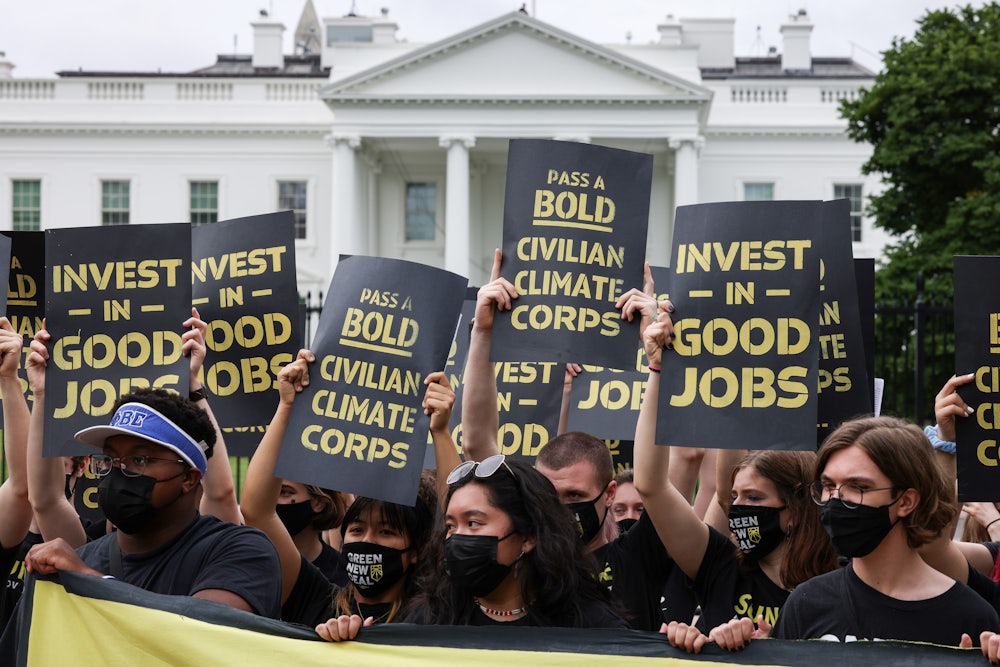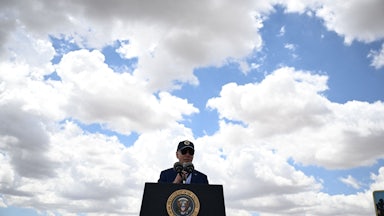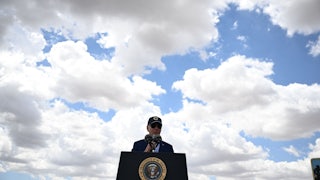Just after the crack of dawn, a few dozen late-teens and twentysomethings stumble from modest cabins into the cafeteria for coffee and a hot breakfast. Group by group, they bus their trays and head out—first to slather on bug spray and sunscreen and then to pick up their supplies for the day: knee-high rain boots, starter plants, and a fresh pair of gloves. Their job this week is planting mangrove trees, whose stubborn, tangly roots are already helping protect these vulnerable shorelines against erosion. Once everyone’s suited up, they load into a bus—electric, of course—emblazoned with a logo starting to show up in more and more places around the country: the American Climate Corps.
The Biden administration this week made very, very small inroads toward turning that hypothetical scene into reality. On Wednesday, the White House announced that it plans to create the American Climate Corps, aimed at preparing “a new generation of Americans to work conserving our lands and waters, bolstering community resilience, advancing environmental justice, deploying clean energy, implementing energy efficient technologies, and tackling climate change.” The announcement came with a sign-up sheet encouraging anyone so inclined to learn more.
A federal climate jobs program has been a longtime demand of the Sunrise Movement, the youth climate group that helped kick off the fight for a Green New Deal in the United States back in late 2018. Announced the same day as a new Office of Gun Violence Prevention, the Corps is clearly aimed at endearing climate voters to Biden in time for 2024. Supporters of the idea are pleased, albeit eager to see more.
“This is a big step in the right direction, and continuing to have action like this in the lead-up to the election will be essential for Joe Biden building support with the youth base,” Sunrise Movement executive director Varshini Prakash told me over the phone on Wednesday. “There remain many, many more things the government can and should do.”
An American Climate Corps isn’t a novel idea for the White House. It was included on the list of priorities put forth by a climate-focused “Unity Task Force” comprised of Biden and Sanders supporters, including Prakash, which convened after Biden won the Democratic presidential nomination in 2020. It then made its way into Biden’s trademark American Jobs Plan, and from there into the doomed Build Back Better framework. Before Democrats could pass their big climate package, though, West Virginia Senator Joe Manchin helped ensure that a Climate Corps and several other proposals were left out of the Inflation Reduction Act, which passed last summer.
The broader inspiration for the American Climate Corps comes from the Civilian Conservation Corps, or CCC, an early New Deal program that put young men to work planting billions of trees and building trails, roads, hunting cabins, and other infrastructure dedicated to both conservation and recreation. Dubbed “Roosevelt’s Tree Army,” the program lasted for about a decade and employed some 2.5 million people. Having piloted similar efforts as governor of New York, Roosevelt first started drawing up plans for the CCC just after his inauguration, eventually bringing Congress a proposal for “Emergency Conservation Work” in late March 1933. By July, the program was up and running and had already met the White House’s initial goal of putting 250,000 men to work.
The American Climate Corps will be meager by comparison, although activists hope it can be the basis for a more expansive climate jobs program down the road. Public details as to how the program will work are still sparse. According to a source familiar with the design of the program, the first jobs will likely start hiring next summer or early fall. The White House has set a goal of employing 20,000 people in the first year. That may sound like a big number, but, for reference, an estimated 75,000 people marched through New York City in climate marches on Sunday. If the program were to meet its goals, that is, it would employ significantly fewer than half the people who showed up to last weekend’s demonstration.
Per the same source, the program will reportedly be administered by a dedicated staff within the Corporation for National and Community Services, which also houses AmeriCorps. That team will coordinate with an initial list of six federal agencies; pending future budget allocations by Congress, Corps members will work on agency projects that have already been funded, including by the Inflation Reduction Act. Agencies already implementing the IRA will work over the coming year with the CNCS to match recruits to eligible positions. In addition to connecting Corps members with federal-level placements, they’ll also work with state-level Climate Corps, tribal programs, and labor unions who can sign up as partners and then can utilize the CNCS as a “national recruitment arm,” per the source.
While AmeriCorps may be the closest living model for a Climate Corps, activists working with the administration to design the program have pushed for those jobs to include a much broader range of positions. AmeriCorps members, that is—often recent college graduates—are not technically government employees. Their stipends amount to less than minimum wage in most states, and they often rely on SNAP benefits to make ends meet. It’s likely that at least a significant portion of Climate Corps jobs will indeed be jobs rather than stipended placements. To the extent that they will be part of a densely unionized federal workforce, Corps members could also be unionized. The minimum length of a Corps post will be 300 hours—about the length of a summer job—and will max out at a year. The program, which won’t require a college degree, is also meant as an on-ramp to climate-related careers in the public sector or union apprenticeship programs that equip members for careers building clean energy infrastructure and other implements of decarbonization.
Absent congressional authority, the ceiling on what a Climate Corps can do via executive order is likely to remain relatively low. That’s part of why, this past week, original Green New Deal resolution sponsors Alexandria Ocasio-Cortez and Ed Markey reintroduced a bill to codify the program into law, opening up additional funding possibilities.
Reflecting a mix of ideological commitments and ad-hoc sausage-making, the IRA is focused largely on one particular aspect of the transition: making clean energy cheaper both for companies and consumers. Tax incentives are meant to make clean energy attractive to investors, who’ll be more likely to offer financing to companies that can put people to work in green jobs. Left out of that picture, though, is all the work that’s necessary for decarbonization and not especially profitable. It’s hard to find a workable business model, for instance, for protecting coastlines against erosion—but that doesn’t mean that work isn’t needed. Those are the types of projects that a Climate Corps could be the most useful for.
While the plans are exceedingly modest for now, the Climate Corps could be a means for Biden to make his environmental agenda resonate with younger voters still smarting from the administration’s approval of the Willow Project. Some of the IRA’s biggest spending buckets are geared toward either corporations or consumers with enough up-front cash to purchase big-ticket items like solar panels and electric cars. With homeownership and major asset purchases still solidly out of reach for many younger voters, the Climate Corps jobs might offer tangible benefits to those left out of the IRA.
“The government has a critical role to play,” Prakash told me, “and I think we need an active government that is involved in addressing the climate crisis and employing millions of people to do that critical work.”










